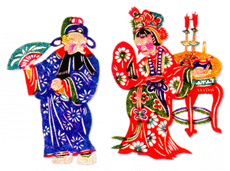Xi'an Arts & CultureAlong with its Terracotta Soldiers, Xi'an has an abundance of Chinese traditional performing arts to represent its long history within China.The culture of Xi'an is inherited from the traditions of one of the world's earliest civilizations.

If you enjoy performing arts then Piying is a must see when in Xi'an. Here, leather puppets are dyed in beautiful bright colors that date back to the Qing Dynasty (1644-1911). There are over 600 different Piying plays. Unlike opera, this is loud, irreverent entertainment tells tales of love, romance and legendary kung-fu epics.
It's a performance of Chang'an music and dance originated in Tang Dynasty over a thousand years ago. It vividly reflects the thriving economy, the friendly relationship between Tang and its neighboring countries, and the folk daily life of the Tang people. Its grand scale, imposing manner, beautiful music, smooth action, and gorgeous costume, all produce the No.1 show for a tourist in China. Tang Dynasty (Tang Yue Gong)
The drama of the original Xi'anese culture, Qinqiang (Voice of Qin) is the oldest and most extensive Chinese Opera of the four major types of Chinese opera. Qinqiang Opera, a popular local opera, has a long tradition in northwest China. It is popular in Shaanxi and Gansu provinces. Because the musicians use Bangzi stick to beat rhythm during play, it is also called "Bang Zi Qiang "as well. You can watch Qin Opera at the following establishments: Shaanxi Opera House ( Shanxi Gewu
Da Xiyuan) Yisu She
Hongguang Cinema
Banpo Neolithic Village Museum The Banpo Museum on the eastern outskirts of the city is the first stop of most eastern tours. It is the excavated site of the Neolithic village, discovered in 1953 and occupied between around 4500 BC and 3750 BC. Banpo is the biggest and best-preserved site of Yangshao culture, and is named after the village near the eastern bend of the Yellow River where the first relics of this culture were found. The village is divided into three areas; the first is a residential section bounded by remains of 46 houses, and constructed half underground around a central fire pit with walls of wood faced with mud and straw. Around the houses are pits, used for storage, and the remains of pens, which would have held domestic animals. North of there is the burial ground, where there are exhibitions of skeletons and funerary objects, though most of it consists of ceramic bowls, jade and bone ornaments. One grave, of a young girl, buried in an earthenware jar, contained 76 objects, including jade earrings and stone balls. Other ceramics found at the site are displayed in the museum wing. They are made by hand of red clay and decorated with images of fish, deer and heads. Also in the museum you can see barbed fish hooks with weights, stone tools, spindles and bone needles. Opening hours: 8:00 am 5:00 pm Shaanxi History Museum One of the city's major highlights is an impressive, modern building just walking distance from the Daxingshan Si and the Big Goose Pagoda. The exhibition halls are spacious, well laid out, and have English captions, displaying a collection of more than three thousand relics. The lower floor, which contains a general survey of the development of civilization until the Zhou dynasty, holds mostly weapons, ceramics and simple ornaments. Most impressive is a superb set of Western Zhou and Shang bronze vessels covered in geometric designs suggestive of animal shapes, used for storing and cooking ritual food. The two upstairs galleries display relics from the Han through the Qing dynasties; notable are the Han ceramic funerary objects, particularly the model houses. The two side halls on the lower floor hold themed exhibitions. The western hall holds bronzes and ceramics. The eastern hall holds a display of Tang gold and silver, mainly finely wrought images of dragons and tiny, delicate flowers and birds, and an exhibition of Tang costume and ornament. Opening hours: 8:30 am 6:00 pm (summer and spring); 9:00 am - 5:30 pm (fall and winter) NOTE: Although this information is correct at the time of our web publication, it is still advised that you call the phone number and confirm the address before going to the venue because some venues may have changed their telephone numbers or address locations. |


